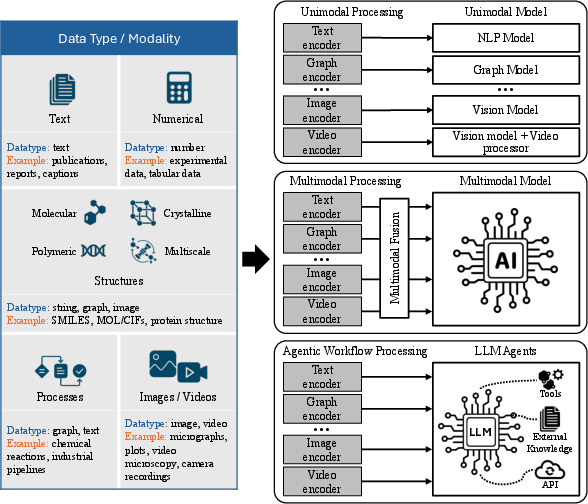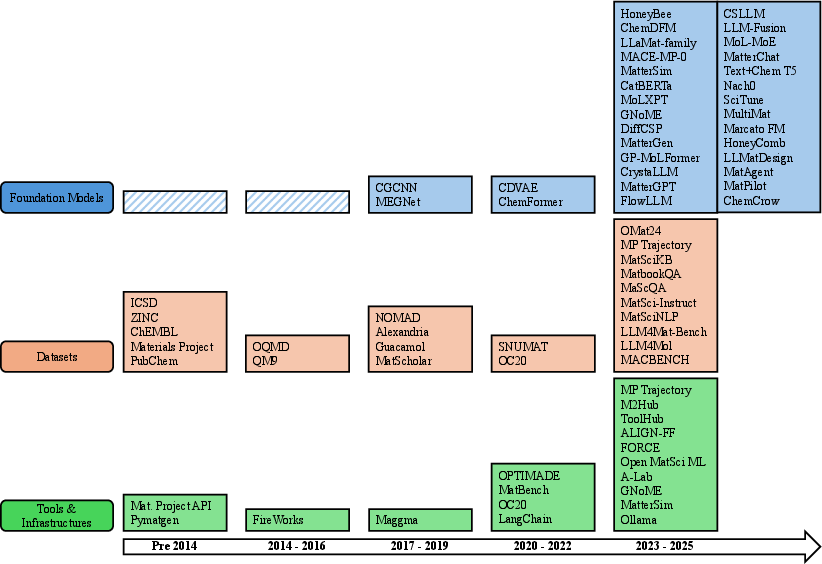- The paper demonstrates how foundation models provide a versatile framework for simulating materials properties and designing novel materials.
- It details the integration of LLM agents to automate experimental workflows and optimize process planning in materials research.
- The study identifies key dataset limitations and computational challenges, urging collaborative efforts to advance AI-driven materials science.
Introduction to AI in Materials Science
The advent of AI has catalyzed a transformative shift in the field of materials science (MatSci), particularly through the innovation of foundation models (FMs). These models offer scalable, general-purpose, and multimodal AI systems that transcend traditional task-specific machine learning approaches. The versatility of FMs is particularly conducive to addressing the diverse research challenges inherent in materials science, which span myriad data types and scales. The survey covered herein provides an expansive overview of the application of foundation models, LLM agents, datasets, and computational tools in this evolving domain.

Figure 1: Overview of our survey of AI for materials science (AI4MS), highlighting common tasks, categories of foundation models, datasets, tools and infrastructures, as well as key discussions on early successes, current limitations, challenges, and future directions.
Foundation Models: Revolutionizing Materials Science
Types and Applications of Foundation Models
Foundation Models (FMs) are large-scale, pretrained models that generalize across diverse downstream tasks, facilitating cross-domain applications with minimal fine-tuning. Key application areas within materials science include:
- Data Extraction, Interpretation, and Q&A: FMs streamline the extraction of structured data from scientific literature, enabling knowledge graph construction from unstructured sources such as research papers and patents.
- Atomistic Simulation: FMs trained on extensive datasets serve as universal simulators, offering near-DFT accuracy in predicting energies and forces across a variety of chemical systems.
- Property Prediction: These models predict electronic, mechanical, thermal, optical, and chemical properties based on structural data, extending their capabilities across conventional boundaries within materials domains.
- Materials Structure, Design, and Discovery: FMs empower generative design by learning inverse relationships between structures and properties, optimizing material design processes for specific attributes or objectives.
- Process Planning and Optimization: Inaugurations such as autonomous laboratories illustrate how FMs are used to automate and optimize experimental procedures—guiding synthesis and procedural operations under real-world constraints.
- Multiscale Modeling: Beyond atomic interactions, FMs hold potential for modeling behavior across scales, uniting atomistic insights with macroscopic performance metrics.

Figure 2: An illustrative example of the interplay of foundation models for materials science with data types and modalities.
Challenges and Limitations
While the successes of FMs in materials science are numerous, several issues persist, limiting their wider adoption and effectiveness:
Emerging Role of LLM-Based Agents
LLM-based agents represent the next evolutionary step in the integration of AI into materials science. These agents utilize the reasoning capabilities of LLMs to facilitate automated discovery and experimental workflows. Prominent examples include HoneyComb, LLMatDesign, and MatAgent, all of which demonstrate advances in autonomous materials discovery and synthesis planning. Nonetheless, these systems also face challenges akin to FM applications, compounded by additional concerns related to biosafety, experimental validity, and human oversight integration.
The development of foundation models relies on expansive, high-quality datasets that span a variety of materials types, and computational and experimental modalities. Datasets such as the Materials Project, Open Catalyst 2020, and QM9 offer rich repositories of atomic structures and properties. Complementing these datasets are tools like Pymatgen and Open MatSci ML Toolkit, which provide efficient conduits for data processing and model development. However, enhancing access to comprehensive and diverse data sets remains critical for advancing the scalability and practicality of AI-driven solutions in materials science.
Conclusion
The survey underscores the transformative potential of foundation models and LLM agents in redefining materials science research. While substantial progress has been made, achieving full integration of AI into materials science necessitates addressing computational, data, and methodological limitations. Collaborative efforts towards democratizing access to data and computational resources, alongside refining model architectures and training paradigms, will be pivotal in advancing this interdisciplinary frontier. These endeavors will ultimately foster the development of more robust, versatile, and widely applicable AI systems poised to enhance material design and discovery processes markedly.


